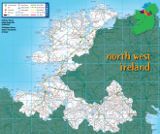Visitor Guide to Mayo, Sligo, Donegal, Roscommon, Leitrim, Cavan & Monaghan
| 0-9 A B C D E F G H I J K L M N O P Q R S T U V W X Y Z |
The Donegal Atlantic Drive
So complex is north Donegal's coast line that any tour can take many variations depending how much time you have. Best views are from minor roads rather than the N56, but skirting the peninsulas is time-consuming, and roads may be poorly surfaced. The highlights of the journey are the sculpted rocks at Crohy Head near Dungloe, the fiery headland known as Bloody Foreland and the panoramic seascapes around Horn Head and Rosguill.
If you still have time and a taste for this gorgeous scenery, Fanad Head by the calm fjord of Lough Swilly, or the pastoral Inishowen Peninsula from which Malin Head relays weather reports, are diverse and unspoilt. Inland, the beautiful and lonely routes through the Glenveagh National Park are well worth exploring. The weather in this part of Ireland is always uncertain, but its very unpredictability is exhilarating, and compensations include amazing sunsets and glorious rainbows. Facilities for tourists along the Donegal coast are limited but steadily increasing. The section between Dungloe and Crolly is known as The Rosses (Na Rosa means 'the headlands'), a bleak, rocky and fragmented coastline, sometimes worn into stacks and arches.
Inland, the terrain is poor, consisting of boulder-strewn bogland waterlogged by myriad tiny lakes and streams. If you have time, you may be able to take a summer boat excursion to Aran Island (also known as Aranmore, but not to be confused with the Aran Islands off Galway Bay) - a 25 minute trip from Burtonport. There's not much to see except bog and lakes, but there are beaches and quiet walks. Tory Island to the north is much less accessible, a treeless wilderness with 200 or so inhabitants who eke out their income from fishing with a school of naïve art. Boat trips leave from Bunbeg or Dunfanaghy, but you may be marooned in bad weather, and there is no accommodation on the island. Balor, Celtic God of darkness, is said to have lived here on the eastern cliffs.
Gweedore, the next peninsula, is scenically austere but densely populated, with new bungalows springing up along the coast. The most scenic stretch is Bloody Foreland a mass of red granite that glows brilliant colour at sunset. The sheer, quartzite cliffs of Horn Head provide terrific views and a windy ledge for thousands of seabirds. Sheep Haven is particularly attractive, and several side-turnings indicate popular holiday resorts. Marble Hill Strand has a fine beach.
Dunfanghy is the main resort, a gentle seaside village near an excellent sandy beach offering windsurfing and canoeing, and a blowhole called McSwyne's Gun which 'explodes' periodically in rough weather. Beyond Dunfanaghy look out for Doe Castle; a 15th-century fortress rebuilt in Victorian times. Views from the Battlements overlook a wide expanse of Sheephaven bay. Lackagh Bridge provides another vantage point. Inland, the barren, rocky landscape is scattered with lakes. the next outcrop is Rosguill, where an 11km circular tour called the Atlantic Drive is signed past dunes and beaches.
Highlights of the Fanad Peninsula include the neat plantation villages of Ramelton and Rathmullan, where Red Hugh O' Donnell, Earl of Tyrconnell, was treacherously lured on to an English merchant ship for a drink, whereupon he was seized and taken to Dublin gaol. On the Inishowen Peninsula, don't miss the stone fort called Grianan of Aileach, Fort Dunree and Malin Head.






